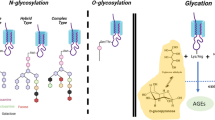Abstract
Purpose. Previously, we suggested that alkylglucoside can be aneffective vector for renal-specific drug delivery (Suzuki et al., J. Pharmacol.Exp. Ther., 288:57–61, 1999). The purpose of the present study is tocharacterize the membrane protein which is recognized by thisalkylglucoside.
Methods. The binding of [125I] tyrosine conjugated with aoctylthioglucoside (Glc-S-C8-[125I]Tyr) Glc-S-C8-[125I]Tyr to crude membranefractions of kidney was determined. In addition, the membrane wascross-linked with this alkylglucoside and examined by sodium dodecylsulfate-polyacrylamide gel electrophoresis.
Results. Glc-S-C8-[125I]Tyr was shown to have a specific binding siteon the kidney membrane (Kd = 931 nM and Bmax = 987pmol/mg protein). Cross-linking of the membrane with Glc-S-C8-[125I]Tyrresulted in the detection of a protein (Mr = 62,000), which wasunaffected by reducing agents. The results of this cross-linking study wereconsistent with previous information on its localization and bindingcharacteristics.
Conclusions. The kidney membrane protein, to which alkylglucosidebinds in a specific manner, has a molecular weight of 62,000.Cross-linking is a useful tool for detecting this novel membrane proteinin kidney.
Similar content being viewed by others
REFERENCES
K. Suzuki, T. Ando, H. Susaki, K. Mimori, S. Nakabayashi, and Y. Sugiyama. Structual requirements for alkylglycoside-type renal targeting vector. Pharm. Res. 16:1026–1034 (1999).
K. Suzuki, H. Susaki, S. Okuno, H. Yamada, H. K. Watanabe, and Y. Sugiyama. Specific renal delivery of sugar-modified low-molecular-weight peptides. J. Pharmacol. Exp. Ther. 288:888–897 (1999).
K. Suzuki, H. Susaki, S. Okuno, and Y. Sugiyama. Renal drug targeting using a vector “alkylglycoside.” J. Pharmacol. Exp. Ther. 288:57–64 (1999).
D. K. Meijer and P. van der Sluijs. Covalent and noncovalent protein binding of drugs: implications for hepatic clearance, storage, and cell-specific drug delivery. Pharm. Res. 6:105–118 (1989).
W. Sadee, V. Drubbisch, and G. L. Amidon. Biology of membrane transport proteins. Pharm. Res. 12:1823–1837 (1995).
H. Saito, S. Masuda, and K. Inui. Cloning and functional characterization of a novel rat organic anion transporter mediating baso-lateral uptake of methotrexate in the kidney. J. Biol. Chem. 271:20719–20725 (1996).
A. M. Pajor. Molecular cloning and functional expression of a sodium-dicarboxylate cotransporter from human kidney. Am. J. Physiol. 270:F642–648 (1996).
M. A. Hediger and D. B. Rhoads. Molecular physiology of sodium-glucose cotransporters. Physiol. Rev. 74:993–1026 (1994).
W. H. Hunter and F. C. Greenwood. Preparation of iodine-131 labeled human growth hormone of high specific activity. Nature 194:495–496 (1962).
F. L. Stassen, R. W. Erickson, W. F. Huffman, J. Stefankiewicz, L. Sulat, and V. D. Wiebelhaus. Molecular mechanisms of novel antagonists: analysis of the effects on vasopressin binding and adenylate cyclase activation in animal and human kidney. J. Pharmacol. Exp. Ther. 223:50–54 (1982).
S. M. Grassl and P. S. Aronson. Na+/HCO3-co-transport in basolateral membrane vesicles isolated from rabbit renal cortex. J. Biol. Chem. 261:8778–8783 (1986).
H. Walter. Tightness and orientation of vesicles from guinea-pig kidney estimated from reactions of adenosine triphosphatase dependent on sodium and potassium ions. Eur. J. Biochem. 58:595–601 (1975).
K. Yamaoka, Y. Tanigawara, T. Nakagawa, and T. Uno. A pharmacokinetic analysis program (multi) for microcomputer. J. Pharmacobio. Dyn. 4:879–885 (1981).
M. T. Vincenzini, T. Iantomasi, M. Stio, C. Treves, F. Favilli, and P. Vanni. 1-O-n-octyl-beta-D-glucopyranoside as a competitive inhibitor of Na+-dependent D-glucose cotransporter in the small intestine brush-border membrane. Biochim. Biophys. Acta 903:273–276 (1987).
H. Kipp, J. T. Lin, and R. K. Kinne. Interactions of alkylglucosides with the renal sodium/D-glucose cotransporter. Biochim. Biophys. Acta 1282:125–130 (1996).
W. S. Lee, Y. Kanai, R. G. Wells, and M. A. Hediger. The high affinity Na+/glucose cotransporter. Re-evaluation of function and distribution of expression. J. Biol. Chem. 269:12032–12039 (1994).
R. J. Turner and A. Moran. Heterogeneity of sodium-dependent D-glucose transport sites along the proximal tubule: evidence from vesicle studies. Am. J. Physiol. 242:F406–414 (1982).
R. J. Turner and A. Moran. Stoichiometric studies of the renal outer cortical brush border membrane D-glucose transporter. J. Membr. Biol. 67:73–80 (1982).
R. J. Turner and A. Moran. Further studies of proximal tubular brush border membrane D-glucose transport heterogeneity. J. Membr. Biol. 70:37–45 (1982).
H. Kipp, R. K. Kinne, and J. T. Lin. Synthesis of the photoaffinity label [1'-14C]-6C-(azimethyl)octylglucoside and its reaction with isolated renal brush border membranes. Anal. Biochem. 245:61–68 (1997).
Author information
Authors and Affiliations
Rights and permissions
About this article
Cite this article
Watanabe, Y., Suzuki, H., Suzuki, K. et al. Detection of the Membrane Protein Recognized by the Kidney-Specific Alkylglucoside Vector. Pharm Res 17, 49–54 (2000). https://doi.org/10.1023/A:1007566408323
Issue Date:
DOI: https://doi.org/10.1023/A:1007566408323




